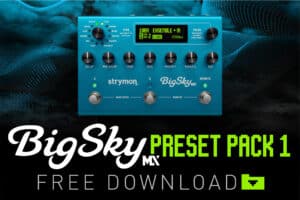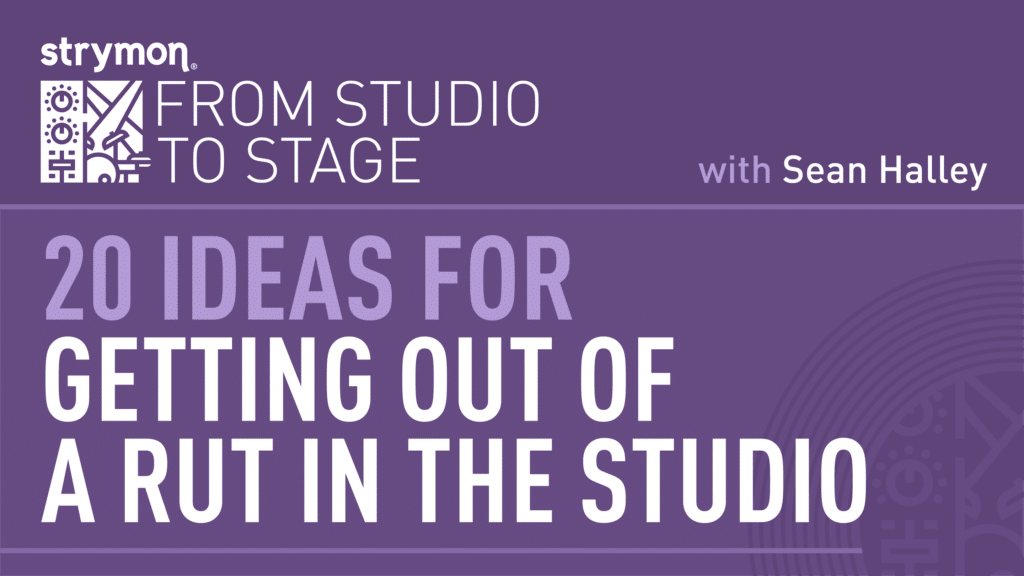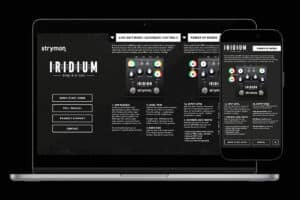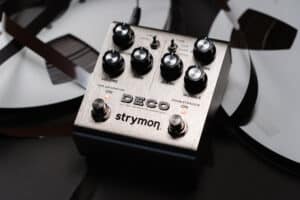
BigSky MX Preset Pack 1
Explore Our First BigSky MX Preset Pack! As part of the latest Nixie 2 update, we’ve put together a free BigSky MX preset pack featuring sounds
Free US Shipping On Orders Over $49
Easy 30-Day Returns
Financing Available Through ![]()

The recording studio used to be a place of mystery, populated by mythical producers and session musicians who were the only ones allowed in, and thus were the only ones affected by the classic Laws Of Recording. These days we’re all doing the home recording thing, so now everyone is subject to the classic truisms of the studio – we just don’t don’t get to smell them (it’s a thing!).
One of those universal laws is “the recording studio is a microscope and reveals all”, and that microscope can get downright claustrophobic if you get into a rut that you just can’t shake off.
Maybe all of a sudden you finally notice that all of your guitars don’t really play in tune all over the neck, or that you tend to sing sharp on long “oh” sounds, or that that bridge you were really proud of is actually just eight bars of filler waiting to go back to the chorus. Whatever the trigger is, once you get into that headspace it can be seriously difficult to break out of and get back to a solid creative flow – so I’m here to help with a proper dose of OldGuyWisdom™!.
What you really need when you get into that space is a sort of “Shakabuku” moment. The term refers to letting go of stuff that doesn’t matter and distracts you from what you’re supposed to be paying attention to (Buddhism, in this case), but Minnie Driver’s description from ‘Grosse Point Blank’ works great too: “Shakabuku is a swift, spiritual kick to the head that alters your reality forever”.
In short, you need a distraction – something to change what you’re currently obsessing over so that you can get back to creating.
So here is a list of 20 things to try that may help in breaking you out of your rut. The list is in no particular order, and all of the items listed here may not apply to you. However, they may help, and you may also find that some of these ideas here help take what you’re working on in a completely new and killer direction.
Play riffs using quarter note, triplet and dotted eighth note values, to see if maybe one of those settings triggers a new inspiration. Try it on the drums even! I re-tracked an entire drum kit while producing years ago because playing around with a delay showed that the little extra skip of a snare on dotted eights made the vocal melody groove stronger – so I had the band’s drummer learn how to play the groove with an extra couple snare hits on the off-beats.
I have owned as many as 30 guitars at once over the years, and each one was chosen because it does something completely different. The studio is all about contrast – especially in tones and texture – so sometimes the very thing you need to make a track come alive is already hanging on the wall somewhere.
In working on a pop tune years ago I knew that I needed a little arpeggio under the verse, but after trying various acoustic and electric guitar options nothing I tried sounded “right”…until I grabbed a bass guitar and played the arpeggio high up on the neck. The actual pitches were the same as when I played them on guitar, but it had all of this thickness from the large strings that the guitars just didn’t have, and it worked perfectly.
If you find something that you like, learn how to play it on a few instruments to see which kind of sound fits better. Improvisors are taught to sing along as they play, so it’s a great skill to develop, and our mouths and brains can often do things outside of our personal experience on our instrument.
Sometimes the part in question has merit, but something about the sonics of it isn’t really translating. If that’s the case, processors like heavy limiters or saturators, ring modulators, backwards reverbs, harmonizers, or triggered synths can let you listen to your original idea in a completely new way. I once searched unsuccessfully for a synth pad sound for the verse of a tune for a full afternoon, and came upon the solution by accident. I’ve had folks ask if it was an Omnisphere patch or something similar, only to find that it was the original Rhodes piano track, chopped up chord-by-chord and played in reverse so that it swells louder towards the end of the bar. Worked a treat.
This works especially well for busy guitar parts, where sometimes the beginning ‘chicc’ of a phrase sounds great on the left speaker, and the sustaining chord that comes later sounds great on the right. Experiment!
Sometimes it’s the journey that gives you a completely new idea, and sometimes what you try just works the first time. I know top mixers that regularly add a little bit of harmonic distortion to everything to simulate tape behavior, but you might only find that amount by starting with waaaaay too much and then backing down. My friend Joe Barrisi did the demos for one of the classic Weezer records on an old Mackie mixer and some digital tape decks, and when they went to Ric Ocasek (who did most of the Weezer stuff) to track it for real they couldn’t get the vibe of the demos. Rik called Joe asking him what magic he did to make them sound that thick, and Joe had to tell him that he had a Big Muff fuzz pedal on a bus return, and fed a little bit of every track to it. Ha ha! Joe is one of the big dogs for a reason!
Fender amps do different things than Voxs and Marshalls do, and as a lover and collector of boutique amps, I can tell you that Bogner, Suhr, Soldano or /13 amps that were inspired by Marshalls do different things than the original amplifiers do. And my ancient Guytron GT100 does completely different things than all of those others, so it’s good to have a toolbox of great tones you can lean on – a different core tone can make a dull part stand up and become much more important.
Stick a mic into the hose from your vacuum and put the other end on your speaker cabinet (or use a garden hose). Or use a rubber warning cone (like from a road crew). With the speaker cab on a hard reflective surface, face the mic at the floor in front of the speaker and flip it out of phase. Find one of those near-silent computer fans (known as a muffin fan), and put it in between the mic and the speaker. Or the end-all-be-all of ridiculous things to try, check out super-engineer Sylvia Massey running a guitar through a pickle. Like, really. A real pickle. It’s silly, but nothing else sounds like it! There are no wrong ideas.
For example, in normal life you’d probably not distort a huge reverb, but you might find that it’s just the thing for a part in one of your tunes. On ‘I Think I Just Said That’ by my band fraudprophets, we ended up creating a silly bridge section after the guitar solo that featured me playing a 1949 Hammond B3 that had been modified with a direct out. So my friend Dave Casey and I ended up running the organ’s direct out into a Big Muff fuzz and wah wah, and then mic’d the Leslie speaker as normal. The section sounds like three different keyboard parts were stacked up, but it’s literally just me playing the organ live and using DAW automation to jump between the direct sound with wah and fuzz and the sound of the mic’d Leslie. It came out pretty cool, and it’s something that I’ll always remember about the process of making that record.
I always hated the thought of using a capo as a youngster, because I felt like I should be able to play anything without it. Ah youth. Anyhoo, grab a capo and put it in a weird high place, and then see if you can play something that works with the tune. It may not work, but it may give you an idea that does.
I know. It sounds simple. Some of us feel like calling a pal to contribute an idea is a hassle, or that you should be able to handle the whole thing by yourself, but sometimes letting someone else take a crack at something is the very best thing that could ever happen, even if it’s just a suggestion. Tom Petty gave Jeff Lynne a songwriting credit on ‘Freefallin’, even though the song was basically complete by the time Jeff heard it. However, it was Jeff that suggested that he go up an octave vocally for the chorus on “I’m Free, free fallin”, and that transformed the tune. Music can be Machiavellian, so embrace it.
Back in my indie producing days I would spend an inordinate amount of time getting the kick drum pattern right before we tracked the drum kit – it’s that integral to the feel and flow of a song’s parts. If something isn’t giving you the feels, mute the kick drum and bass guitar and plonk around with some different ideas to see if it triggers a solution to your problem.
Grab a laptop and get to the beach or to the forest, and try creating in a different environment. The only time I’ve been to a redwood forest, I immediately wanted to come back with a laptop and a set of nearfield speakers and work. It was silent, but naturally, not because of sonic treatment in a control room. It felt amazing, and it would have been a real inspiration had I been able to do it.
I had a student for awhile that recorded everything through a portable cassette recorder before it hit the DAW. The extra warble and filtering from the lossy medium became a signature part of his process. My dear friend and multi-Grammy nominated engineer/producer Dana Nielsen used to write on his couch using only a simple standalone recorder to capture his ideas, even though he has a full studio a few rooms away. It is often the act of working with limitations that triggers creativity (See #20).
Moving to a different instrument you aren’t that familiar with will force you to use your ears instead of familiar finger patterns, and that almost always yields interesting results. I know great keyboard players that don’t play guitar well, but often write with one, because they come up with really interesting chord movements by just following their ears. In my book you also get bonus points if it’s an instrument off the beaten track (pedal steel, dulcimer, hammered dulcimer, recorder, zither, etc).
This can mean using a guitar synth controller (the ones folks seem to be talking about these days are from Jamstik), or trying something oddball like an old Boss DR5, which has rubberized buttons that are laid out like a guitar fretboard, so you can sort of play it like you were Jeff Healey (flat on your lap or a desk).
Some of my fave Wurlitzer sounds I got back in my indie producing days were mic’d through an ancient boombox someone left at the studio. I ended up using that thing until the speakers rotted out, because it did such a great job on all sorts of instruments. Lots of Bluetooth speakers have Aux inputs these days, so give it a shot, you might be surprised – Brian May and Jimmy Page used small amps in the studio for a reason.
I created a class on producing full tracks using only “Found Sounds” back when I was still running the production department at LACM in Los Angeles, and it’s a fascinating thing. I’ve seen students create pads out of filled wine glasses, drum tracks using only a pillow and some pencils and glasses, and synth parts using an electric shaver as the oscillator. It can be cathartic, and super interesting – if you use the arm of your Barcalounger as a kick drum, no one else will have the same sound, guaranteed.
These days it’s easy to rack up sixty tracks of backing vocals, even if you’re recording on an iPad, so give yourself an arbitrary limit. “Sgt Pepper” by The Beatles? Four tracks. “Sweet Dreams Are Made Of This” by The Eurythmics? Eight tracks. When you limit your total number of playable tracks, you have to make very different decisions, and that can be invigorating!
I hope this helps get you out of your rut, or at the very least helps your tunes not sound like everyone else!
More in a bit.
S.
Subscribe to our newsletter to be the first to hear about new Strymon products, artist features, and behind the scenes content!

Explore Our First BigSky MX Preset Pack! As part of the latest Nixie 2 update, we’ve put together a free BigSky MX preset pack featuring sounds

If you happen to be one of those Strymon owners who know that their favorite units might have some extra capabilities but can’t remember exactly

From our favorite artists’ new releases to amazing concerts, and existing artists we’re just finding out about, 2024 was a year filled with great music.